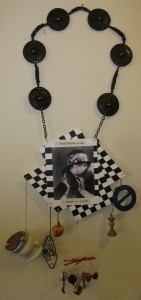 It would be difficult to find an artist since 1917 who was not influenced by Marcel DuChamp. That was the year he exhibited a urinal in a gallery, called it “Fountain”, signed it R.Mutt, and declared it art. This was as much a paradigm-shifter as the arrival of the camera in the 19th century.
It would be difficult to find an artist since 1917 who was not influenced by Marcel DuChamp. That was the year he exhibited a urinal in a gallery, called it “Fountain”, signed it R.Mutt, and declared it art. This was as much a paradigm-shifter as the arrival of the camera in the 19th century.
DuChamp did not paint pictures or make sculptures after his early studies. He was interested in ‘readymades’, which began with a bicycle wheel he kept in his studio to look at. Sometimes he put his readymades together and made a sort of rough and ready sculpture out them – about 30 years before Dubuffet called them ‘assemblages’. He not only made ‘mobiles’, it was he who suggested that name to Alexander Calder for his kinetic sculptures.
The structure for Marcel is based on a chessboard pattern because he gave up being an artist to play chess for the last 30 years of his life. The image of Marcel I have chosen is as “Rose Sélavy” an alter ego frequently photographed by Man Ray. Marcel DuChamp was different from me in every way. He was a dadaist, a surrealist, a mathematician, a Cubist, an eroticist, a cigar-smoker, an art dealer. He was not interested in aesthetics. His readymades were utilitarian and mostly untransformed. And yet his ideas about art are all-pervasive. He made it possible for art to be overtly political, to make a statement, to be silly, to use any materials and any technique or no technique, to be simply a concept. And he did not share society’s reverence of Art. His freedom of thought freed art.